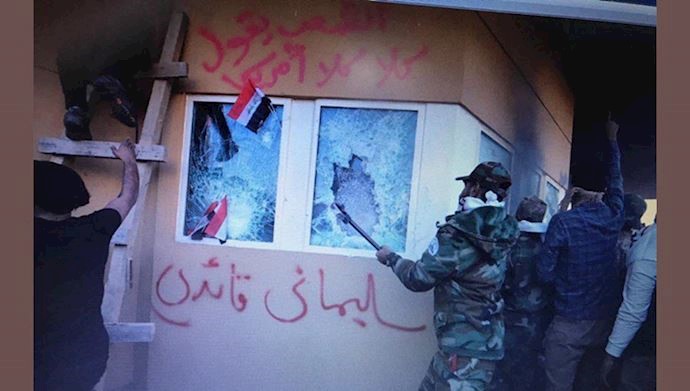Reporting by PMOI/MEK
Iraq, January 1, 2020—Members and supporters of militia groups supported by the mullahs’ regime in Iran stormed into Baghdad’s supposedly heavily-fortified Green Zone and attacked the U.S. Embassy compound. Militia leaders such as Badr Corps chief Hadi al-Ameri, Asaeb Ahl al-Haq chief Qais al-Khazali, Hashd al-Shaabi (PMF) chief Abu Mahdi al-Mohandes, and Iraqi National Security Advisor Falih Alfayyadh, all known for their close ties to Tehran and the Revolutionary Guards (IRGC) Quds Force chief Qasim Soleimani, were present at the scene of the attacks.
“The attack today was orchestrated by terrorists – Abu Mahdi al Muhandis and Qays al-Khazali – and abetted by Iranian proxies – Hadi al Amari and Faleh al-Fayyad. All are pictured below outside our embassy,” said U.S. Secretary of State Mike Pompeo in this regard.
The attack today was orchestrated by terrorists – Abu Mahdi al Muhandis and Qays al-Khazali – and abetted by Iranian proxies – Hadi al Amari and Faleh al-Fayyad. All are pictured below outside our embassy. pic.twitter.com/2QfGGrfmDd
— Secretary Pompeo (@SecPompeo) 31 December 2019
The militia members and supporters attacking the U.S. Embassy compound in Baghdad wrote in graffiti, “Qasem Soleimani is our leader,” clearly indicating Tehran’s direct role in orchestrating these attacks.
“Iran killed an American contractor, wounding many”
We strongly responded, and always will. Now Iran is orchestrating an attack on the U.S. Embassy in Iraq. They will be held fully responsible. In addition, we expect Iraq to use its forces to protect the Embassy, and so notified!” said U.S. President Donald Trump, emphasizing Tehran orchestrating the entire attack.
Iran killed an American contractor, wounding many. We strongly responded, and always will. Now Iran is orchestrating an attack on the U.S. Embassy in Iraq. They will be held fully responsible. In addition, we expect Iraq to use its forces to protect the Embassy, and so notified!
— Donald J. Trump (@realDonaldTrump) 31 December 2019
This is the first time that the U.S. government considers no distinctions between the Iranian regime and its proxy militia groups in Iraq. This is yet another result of Washington bringing an end to decades of failed appeasement vis-à-vis Tehran’s mullahs.
On Wednesday, January 1, after another surge of attacks similar to the day before and the U.S. and Iraqi security forces firing tear gas, the PMF ordered its units to dismantle their tents outside the U.S Embassy compound and withdraw from the area. The militia members and supporters went on to set up camp outside the Green Zone, according to Sky News Arabia.
On Tuesday, al-Hadath TV also reported that Badr Corps chief Hadi al-Ameri and Asaeb chief Qeis al-Khazaeli were directing the events on the ground in the attack against the U.S. Embassy. This report also included the names of Abu Mahdi al-Mohandes, senior militia official Hamid al-Jazaeri and Falih Alfayyadh in the attacks. The militia members and supporters were able to set fire to one of the U.S. Embassy gates, vandalize a number of security cameras around the U.S. Embassy and torch a U.S. Embassy security trailer in the same area.
The U.S. Ambassador to Iraq and numerous Embassy personnel departed Baghdad on Tuesday due to security concerns, according to Reuters. The U.S. administration has time and again warned the Iraqi government and provided intelligence about the militia groups’ intention to attack the embassy, a senior State Department official told journalists in Washington on Tuesday.
“….Iran will be held fully responsible for lives lost, or damage incurred, at any of our facilities. They will pay a very BIG PRICE! This is not a Warning, it is a Threat,” U.S. President Donald Trump said in another tweet on Tuesday.
….Iran will be held fully responsible for lives lost, or damage incurred, at any of our facilities. They will pay a very BIG PRICE! This is not a Warning, it is a Threat. Happy New Year!
— Donald J. Trump (@realDonaldTrump) 31 December 2019
“Today’s attack against the U.S. Embassy should not be confused with the legitimate efforts of the Iraqi protestors who have been in the streets since October working for the people of Iraq to end the corruption exported there by the Iranian regime,” said U.S. Secretary of State Mike Pompeo in another tweet on Tuesday.
Today’s attack against the U.S. Embassy should not be confused with the legitimate efforts of the Iraqi protestors who have been in the streets since October working for the people of Iraq to end the corruption exported there by the Iranian regime.
— Secretary Pompeo (@SecPompeo) 31 December 2019
“To the Iranian government: Be careful what you wish for — a country that depends on the ability to refine oil for its existence needs to be cautious,” said Senator Lindsey Graham in a tweet on Tuesday.
The scenes orchestrated on Tuesday by the Iranian regime in Baghdad were very similar to the 1979 storming of the U.S. Embassy in Tehran. 40 years ago, the mullahs’ regime resorted to such a measure by launching a major international crisis to cloak its inability to respond to the Iranian society’s demands for freedom and democracy following the 1979 revolution.
40 years later, again facing domestic crises with the November uprising, and major international dilemmas with U.S. sanctions and nations in Iraq and Lebanon protesting its meddling, Tehran’s mullahs have resorted to yet another similar charade. They are in desperate need to save face, knowing all these developments are portraying a very weak image of their regime and making them completely vulnerable, especially in the face of a new nationwide uprising in the making by the Iranian people.





